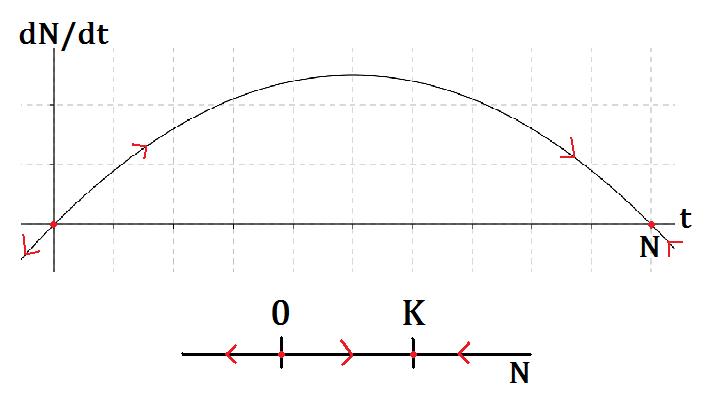Or search by topic
Number and algebra
Geometry and measure
Probability and statistics
Working mathematically
Advanced mathematics
For younger learners
Population Dynamics - Part 3



- Problem
- Student Solutions

We first solve this equation: $$\begin{align*} \frac{\mathrm{d}N}{\mathrm{d}t}&=rN(1-\frac{N}{K}) \\ \frac{1}{K} \frac{\mathrm{d}N}{\mathrm{d}t} &= \frac{N}{K} r(1-\frac{N}{K}) \end{align*}$$ To simplify this, let $x=\frac{N}{K}$ $$\begin{align*} \frac{\mathrm{d}x}{\mathrm{d}t}&=xr(1-x) \\ \frac{\mathrm{d}x}{x(1-x)}&=r\mathrm{d}t \\ \Big( \frac{1}{x}+\frac{1}{1-x} \Big) \mathrm{d}x&=r\mathrm{d}t \\ ln\Big(\frac{x}{1-x}\Big)&=rt+c \\ \frac{x}{1-x}&=X_0e^{rt} \\ x&=X_0e^{rt}-x X_0e^{rt} \\ x&=\frac{X_0e^{rt}}{1+X_0e^{rt}} \end{align*}$$ Putting N back in: $$N(t)=\frac {K N_0 e^{rt}}{K+N_0 (e^{rt}-1)}$$As expected, over time the population tends to the maximum allowed by the environment: $$\lim_{t\to\infty} N(t)=K$$
Related Collections
You may also like
Ball Bearings
If a is the radius of the axle, b the radius of each ball-bearing, and c the radius of the hub, why does the number of ball bearings n determine the ratio c/a? Find a formula for c/a in terms of n.
Overarch 2
Bricks are 20cm long and 10cm high. How high could an arch be built without mortar on a flat horizontal surface, to overhang by 1 metre? How big an overhang is it possible to make like this?
Cushion Ball
The shortest path between any two points on a snooker table is the straight line between them but what if the ball must bounce off one wall, or 2 walls, or 3 walls?

